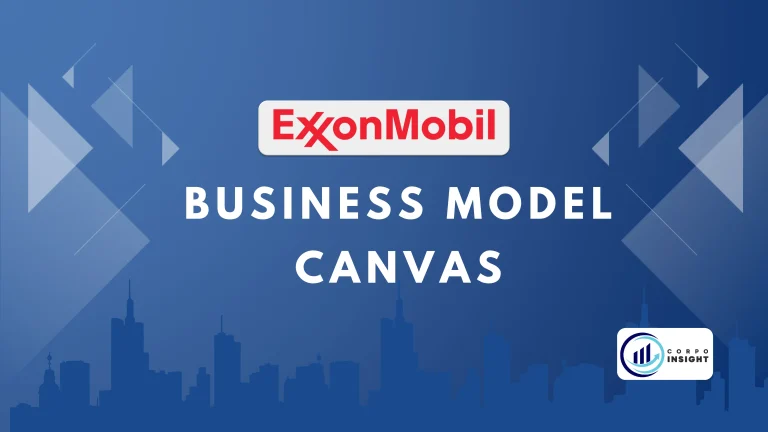Patagonia Business Model Canvas 2024
Founded by avid climber and environmentalist Yvon Chouinard in 1973 as a maker of rugged mountain climbing gear, Patagonia has grown into an outdoor clothing and equipment juggernaut renowned for its commitment to sustainability and environmental activism, donating time and a self-imposed “Earth tax” to numerous grassroots organizations while pioneering the use of recycled materials and embracing ethical labor practices. In this Patagonia Business Model Canvas, I will identify its customer segments, value proposition, revenue streams, channels, customer relationships, key activities, key resources, key partners, and cost structure.
Interesting fact!
Early Patagonia catalogs were handwritten, photocopied, and stapled together by employees to foster a homegrown, personal feel.
Patagonia Competitors
The North Face | Columbia Sportswear | Arc’teryx | REI Co-op | Marmot | Outdoor Research | Fjällräven | Kuhl | Prana | Black Diamond Equipment
Customer Segments – Patagonia Business Model Canvas
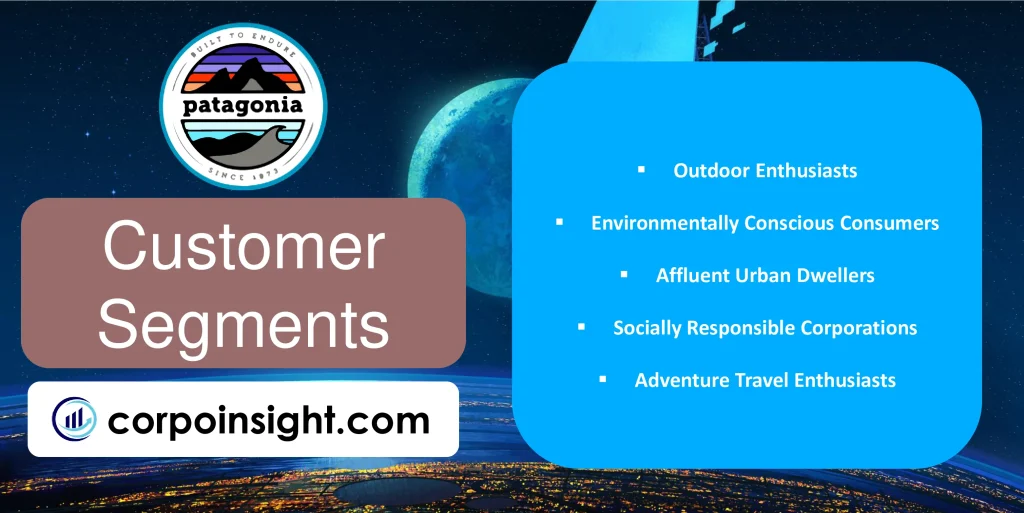
1. Outdoor Enthusiasts: Patagonia’s core customer base consists of individuals who are passionate about outdoor activities such as hiking, climbing, camping, and surfing, as the company’s products are designed to withstand the rigors of these pursuits while promoting environmental sustainability.
2. Environmentally Conscious Consumers: With its strong commitment to environmental protection and ethical business practices, Patagonia attracts consumers who prioritize eco-friendliness and social responsibility, resonating with their values and aligning with their desire to support sustainable brands.
3. Affluent Urban Dwellers: Despite its outdoor-focused product line, Patagonia has successfully tapped into a segment of affluent urban consumers who appreciate the brand’s quality, durability, and stylish appeal, positioning its products as versatile for both outdoor adventures and city living.
4. Socially Responsible Corporations: Recognizing the increasing importance of corporate social responsibility, Patagonia has gained a following among companies seeking to outfit their employees with high-quality, environmentally conscious apparel and gear, aligning with their commitment to sustainable business practices.
5. Adventure Travel Enthusiasts: With the rising popularity of adventure travel and experiential vacations, Patagonia has captured a segment of consumers seeking performance-oriented clothing and equipment tailored for exploring remote destinations and engaging in rugged outdoor activities during their travels.
Value Proposition – Patagonia Business Model Canvas
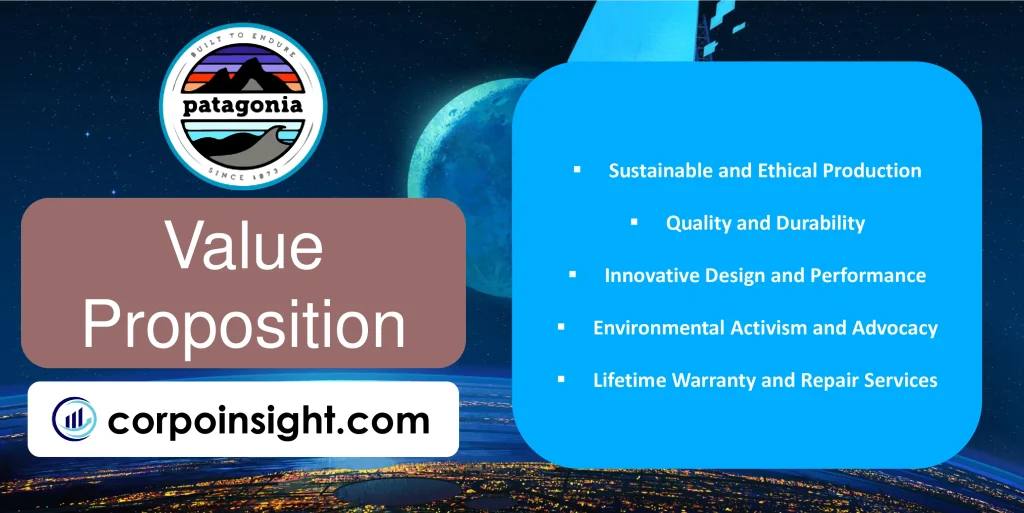
1. Sustainable and Ethical Production: Patagonia’s commitment to sustainability and ethical business practices, which includes using recycled materials, fair labor practices, and environmentally responsible manufacturing processes, resonates with consumers who value responsible consumption and environmental stewardship.
2. Quality and Durability: Known for its high-quality and durable products designed to withstand the rigors of outdoor adventures, Patagonia offers consumers long-lasting gear that not only performs exceptionally but also reduces the need for frequent replacements, aligning with its sustainability ethos.
3. Innovative Design and Performance: Consistently pushing the boundaries of innovation, Patagonia’s products incorporate cutting-edge technologies and design elements that enhance performance and functionality, catering to the demands of outdoor enthusiasts and adventure seekers who require specialized gear.
4. Environmental Activism and Advocacy: Beyond its sustainable business practices, Patagonia actively supports environmental causes and advocates for the protection of natural resources, fostering a strong connection with consumers who share these values and seek to align their purchases with companies that promote positive change.
5. Lifetime Warranty and Repair Services: Patagonia’s commitment to product longevity is reinforced by its comprehensive lifetime warranty and repair services, which not only ensure customer satisfaction but also contribute to reducing waste and promoting a circular economy mindset.
Revenue Streams – Patagonia Business Model Canvas
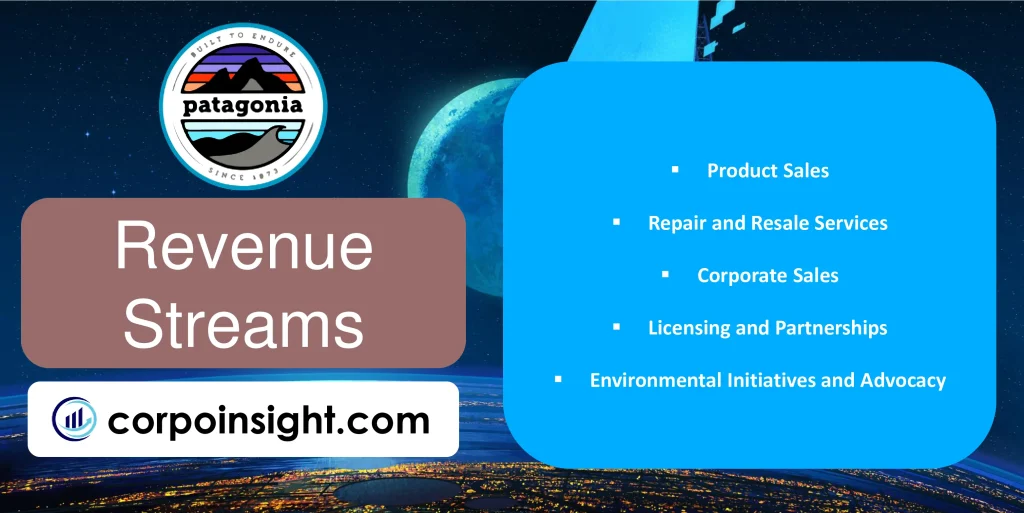
1. Product Sales: Patagonia’s primary revenue stream stems from the direct sale of its extensive line of outdoor apparel, gear, and equipment through its various channels, including brick-and-mortar retail stores, e-commerce platforms, and wholesale distribution networks.
2. Repair and Resale Services: Complementing its product sales, Patagonia generates revenue from its repair and resale services, which not only extend the lifespan of its products but also align with the company’s commitment to sustainability and reducing waste.
3. Corporate Sales: Recognizing the growing demand for sustainable and ethically produced corporate apparel, Patagonia has established a dedicated corporate sales division, generating revenue by catering to businesses and organizations seeking to outfit their employees with high-quality, eco-friendly gear.
4. Licensing and Partnerships: Leveraging its strong brand recognition and reputation, Patagonia generates revenue through licensing agreements and strategic partnerships with complementary brands and companies, enabling them to leverage Patagonia’s brand equity while expanding its reach into new markets.
5. Environmental Initiatives and Advocacy: While not a direct revenue stream, Patagonia’s commitment to environmental advocacy and support for grassroots organizations indirectly contributes to its revenue by fostering brand loyalty and attracting consumers who value companies that align with their values and promote positive change.
Channels – Patagonia Business Model Canvas
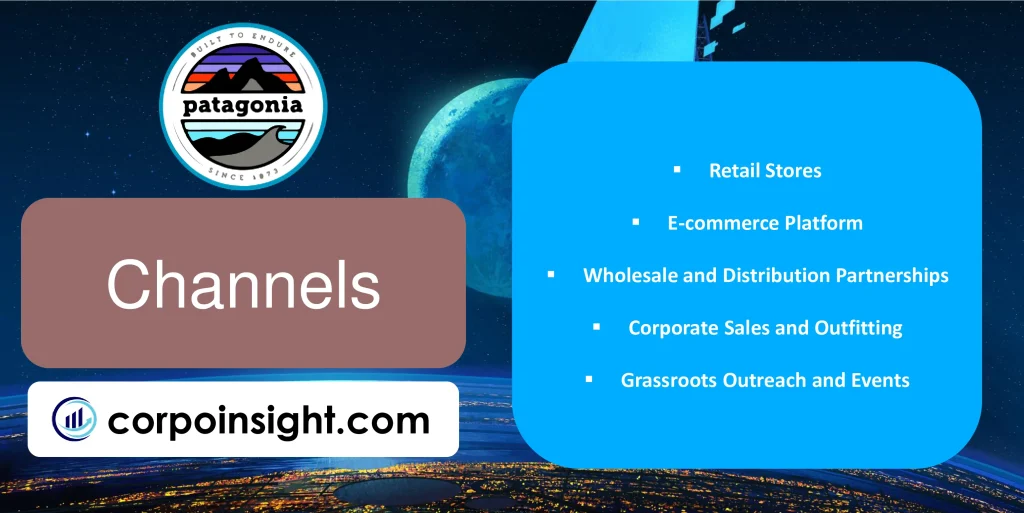
1. Retail Stores: Patagonia operates a network of company-owned retail stores strategically located in major cities and outdoor recreation hotspots, providing customers with a hands-on experience and the ability to interact directly with knowledgeable staff and explore the brand’s extensive product offerings.
2. E-commerce Platform: Recognizing the growing importance of digital channels, Patagonia has invested in a robust e-commerce platform that not only facilitates online sales but also serves as a hub for brand storytelling, product education, and customer engagement, catering to the preferences of tech-savvy consumers.
3. Wholesale and Distribution Partnerships: To expand its reach and availability, Patagonia has established strategic partnerships with various outdoor retailers, specialty stores, and distribution networks, ensuring its products are accessible to consumers across diverse markets and geographical locations.
4. Corporate Sales and Outfitting: Through its dedicated corporate sales division, Patagonia has developed a channel specifically tailored to meet the needs of businesses and organizations seeking to outfit their employees with high-quality, sustainable apparel and gear, aligning with their corporate values and sustainability initiatives.
5. Grassroots Outreach and Events: Leveraging its strong connection with the outdoor community, Patagonia actively participates in and sponsors various grassroots events, festivals, and initiatives, fostering brand awareness, building customer loyalty, and reinforcing its commitment to environmental stewardship and advocacy.
Customer Relationships – Patagonia Business Model Canvas
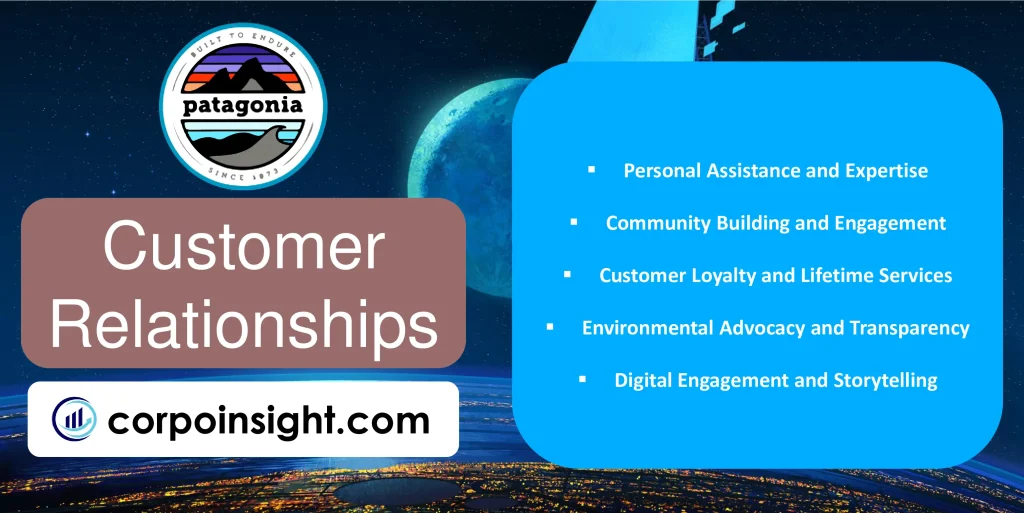
1. Personal Assistance and Expertise: Patagonia fosters strong customer relationships by providing personalized assistance and expertise through its knowledgeable staff, who are not only well-versed in the brand’s products but also share a passion for outdoor activities, enabling them to offer tailored recommendations and insights.
2. Community Building and Engagement: Recognizing the importance of creating a sense of belonging, Patagonia actively cultivates a community of like-minded individuals by organizing events, workshops, and initiatives that bring together outdoor enthusiasts, environmental advocates, and brand loyalists, fostering a deeper connection beyond mere transactions.
3. Customer Loyalty and Lifetime Services: Patagonia’s commitment to customer satisfaction extends beyond the initial purchase, offering comprehensive lifetime warranties, repair services, and product care resources, which not only strengthen customer loyalty but also reinforce the brand’s values of quality, durability, and environmental responsibility.
4. Environmental Advocacy and Transparency: By actively supporting environmental causes and promoting transparency in its operations and supply chain, Patagonia establishes a deeper connection with customers who share similar values, positioning itself as a brand that aligns with their ethical and environmental concerns.
5. Digital Engagement and Storytelling: Leveraging digital channels, Patagonia cultivates customer relationships through engaging storytelling, product education, and online communities, providing a platform for customers to connect with the brand, share experiences, and gain insights into the company’s philosophy and initiatives.
Key Activities – Patagonia Business Model Canvas
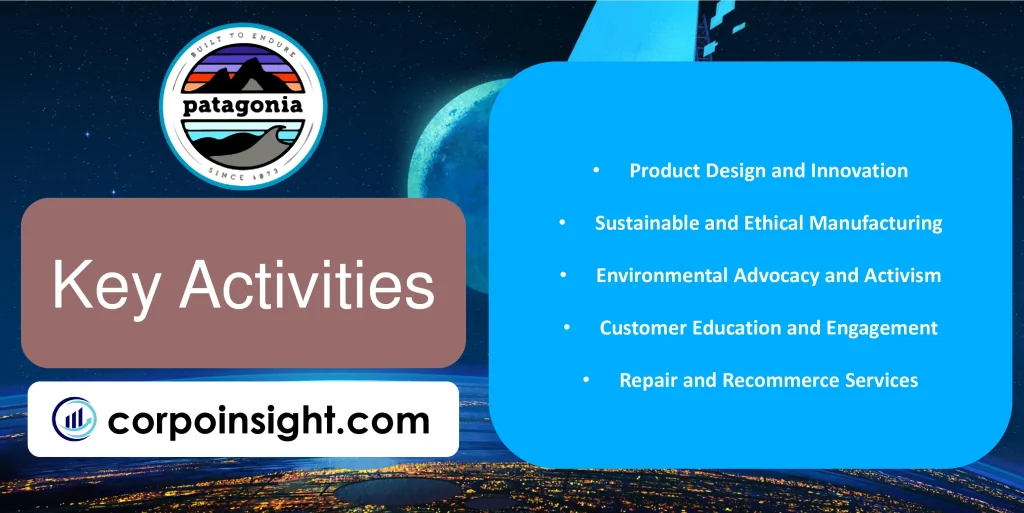
1. Product Design and Innovation: At the core of Patagonia’s operations lies a relentless pursuit of product design and innovation, driven by a team of skilled designers and engineers who continuously push the boundaries of performance, functionality, and sustainability in outdoor apparel and gear.
2. Sustainable and Ethical Manufacturing: Patagonia’s commitment to environmental responsibility is exemplified in its rigorous sustainable manufacturing practices, which encompass the use of recycled materials, implementation of eco-friendly processes, and adherence to stringent ethical labor standards throughout its supply chain.
3. Environmental Advocacy and Activism: Beyond its business operations, Patagonia actively engages in environmental advocacy and activism, supporting grassroots organizations, promoting awareness, and influencing policy changes to protect natural resources and combat climate change, aligning with its core values and mission.
4. Customer Education and Engagement: Recognizing the importance of fostering a community of informed and engaged customers, Patagonia dedicates significant efforts to customer education through various channels, including in-store events, online resources, and partnerships with like-minded organizations, empowering individuals to make sustainable choices.
5. Repair and Recommerce Services: Embracing a circular economy approach, Patagonia offers comprehensive repair and recommerce services, extending the lifespan of its products, reducing waste, and promoting responsible consumption practices among its customer base, further reinforcing its commitment to sustainability.
Key Resources – Patagonia Business Model Canvas
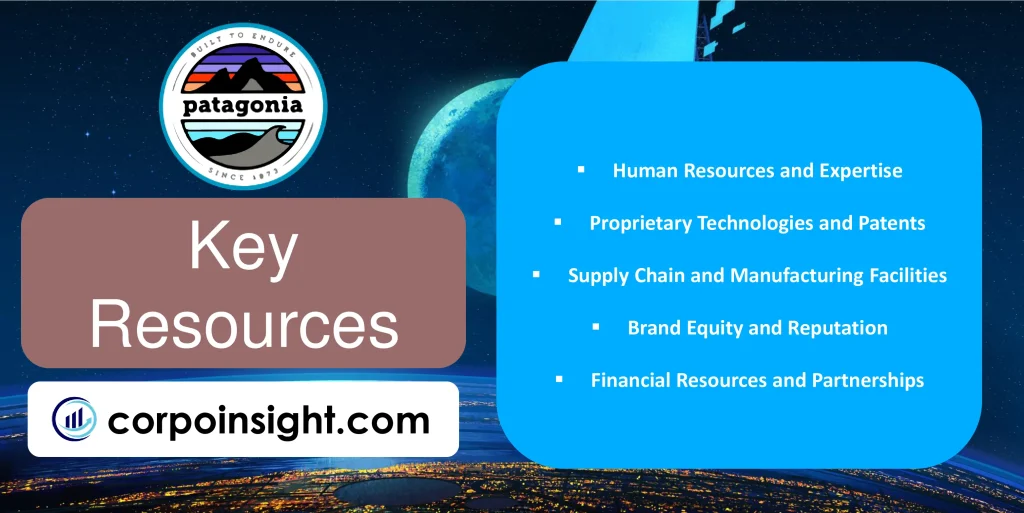
1. Human Resources and Expertise: Patagonia’s success heavily relies on its talented and passionate workforce, comprising skilled designers, engineers, and outdoor enthusiasts who bring their expertise and shared values to the table, driving innovation, sustainability, and an unwavering commitment to the brand’s mission.
2. Proprietary Technologies and Patents: Over the years, Patagonia has invested in developing proprietary technologies and securing patents for its innovative designs and materials, enabling the company to differentiate its products, enhance performance, and maintain a competitive edge in the outdoor apparel and gear market.
3. Supply Chain and Manufacturing Facilities: Patagonia’s commitment to sustainability extends to its carefully curated supply chain and manufacturing facilities, which adhere to stringent environmental and ethical standards, ensuring the responsible sourcing and production of its products while minimizing its ecological footprint.
4. Brand Equity and Reputation: Patagonia’s strong brand equity and reputation as a pioneering and purpose-driven company have become invaluable resources, fostering customer loyalty, trust, and a willingness to support the brand’s initiatives and advocacy efforts, further solidifying its position in the market.
5. Financial Resources and Partnerships: While operating as a privately held company, Patagonia has cultivated strategic partnerships and leveraged its financial resources to support its growth, fund research and development efforts, and invest in sustainable practices and environmental causes aligned with its core values.
Key Partners – Patagonia Business Model Canvas
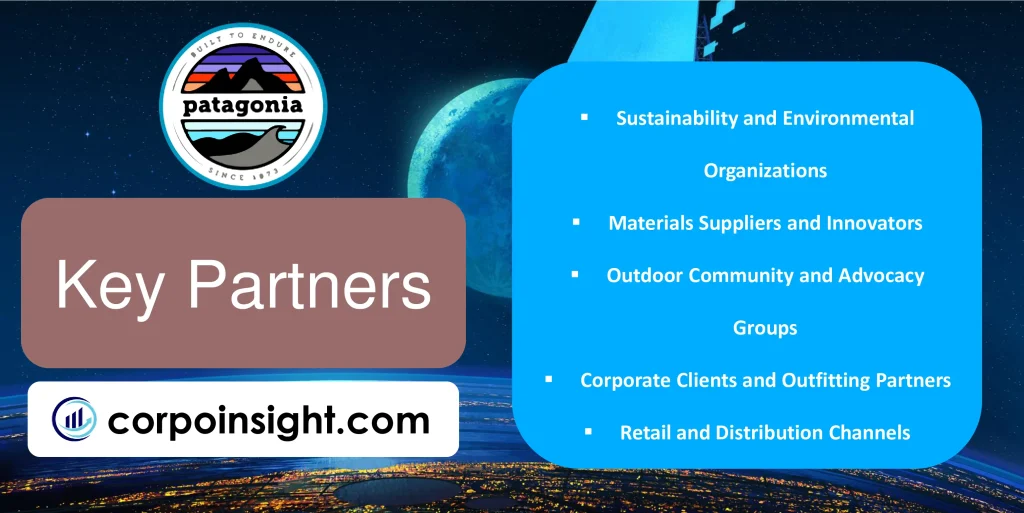
1. Sustainability and Environmental Organizations: Patagonia has forged strong partnerships with numerous sustainability and environmental organizations, such as the Conservation Alliance and 1% for the Planet, collaborating on initiatives aimed at promoting environmental protection, advocating for policy changes, and supporting grassroots conservation efforts.
2. Materials Suppliers and Innovators: To maintain its commitment to sustainability and innovation, Patagonia partners with cutting-edge materials suppliers and innovators, co-developing and sourcing eco-friendly fabrics, insulations, and technologies that enable the creation of high-performance yet environmentally responsible products.
3. Outdoor Community and Advocacy Groups: Recognizing the importance of fostering a sense of community and shared values, Patagonia actively partners with various outdoor enthusiast groups, advocacy organizations, and non-profits, supporting their missions, amplifying their voices, and promoting responsible stewardship of natural resources.
4. Corporate Clients and Outfitting Partners: Patagonia has established strategic partnerships with corporations and organizations seeking to outfit their employees with sustainable and ethically produced apparel and gear, aligning with their corporate social responsibility goals and contributing to Patagonia’s revenue streams.
5. Retail and Distribution Channels: To expand its reach and availability, Patagonia collaborates with a network of retail partners, specialty stores, and distribution channels, ensuring its products are accessible to consumers across diverse markets and geographical locations while maintaining brand integrity and consistent customer experiences.
Cost Structure – Patagonia Business Model Canvas
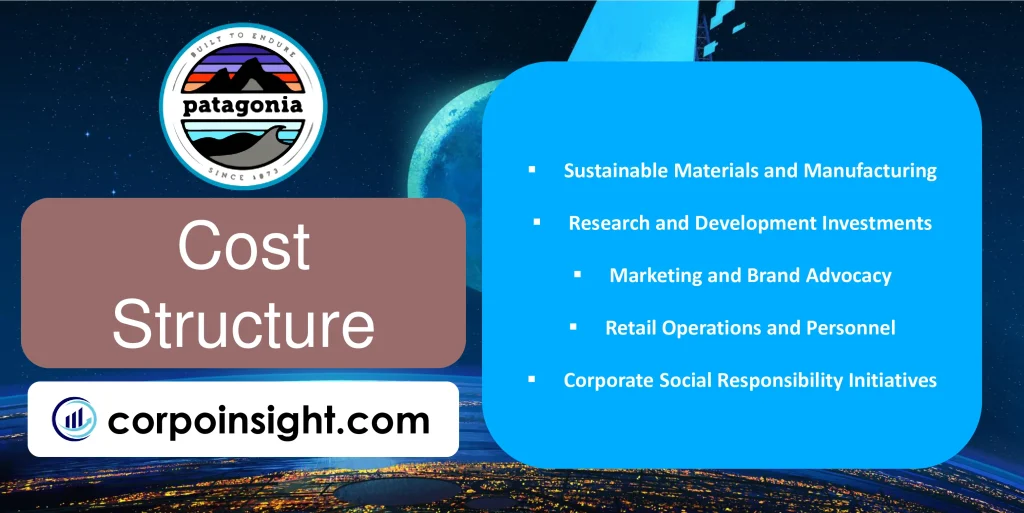
1. Sustainable Materials and Manufacturing: Patagonia’s unwavering commitment to sustainability and ethical practices necessitates higher costs associated with sourcing eco-friendly materials, implementing environmentally responsible manufacturing processes, and adhering to stringent labor standards throughout its supply chain.
2. Research and Development Investments: To maintain its position as an innovator in the outdoor apparel and gear industry, Patagonia allocates significant resources towards research and development, investing in cutting-edge technologies, product design, and performance enhancements, which contribute substantially to its overall cost structure.
3. Marketing and Brand Advocacy: While adopting a relatively understated approach to traditional advertising, Patagonia dedicates substantial resources to marketing efforts that align with its brand values, such as environmental advocacy campaigns, community outreach initiatives, and storytelling endeavors that resonate with its target audience.
4. Retail Operations and Personnel: As a vertically integrated company with a robust network of retail stores, Patagonia incurs significant costs associated with operating and maintaining its physical locations, as well as staffing them with knowledgeable and passionate personnel capable of delivering exceptional customer experiences.
5. Corporate Social Responsibility Initiatives: Consistent with its mission and values, Patagonia allocates a portion of its revenue towards various corporate social responsibility initiatives, including environmental preservation efforts, support for grassroots organizations, and advocacy campaigns, representing a notable component of its overall cost structure.
Summary of Patagonia Business Model Canvas
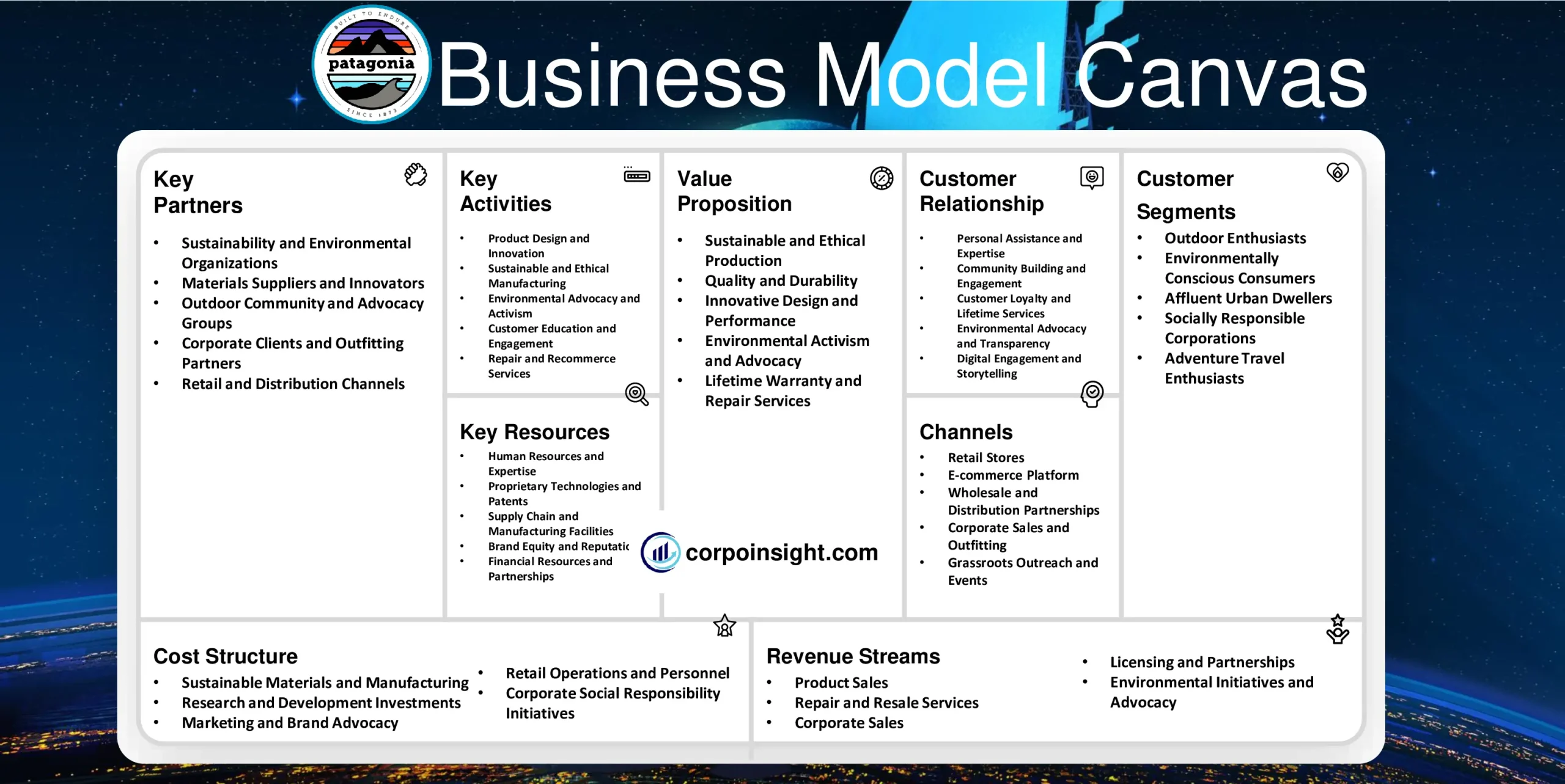
Conclusion on Patagonia Business Model Canvas
In conclusion, Patagonia’s business model canvas reflects a harmonious blend of commercial success and environmental stewardship. By offering high-quality, innovative products and fostering strong customer relationships, the company generates revenue while adhering to sustainable practices, ethical manufacturing, and a commitment to environmental advocacy. Patagonia’s success lies in its ability to align its operations with its core values, resonating with conscientious consumers and setting an example for purpose-driven businesses.

This is Ahsanul Haque, someone very passionate about digital marketing, SEO, and Data Analytics and founder of the Analytics Empire and currently pursuing my major in marketing at Bangladesh University of Professionals.


